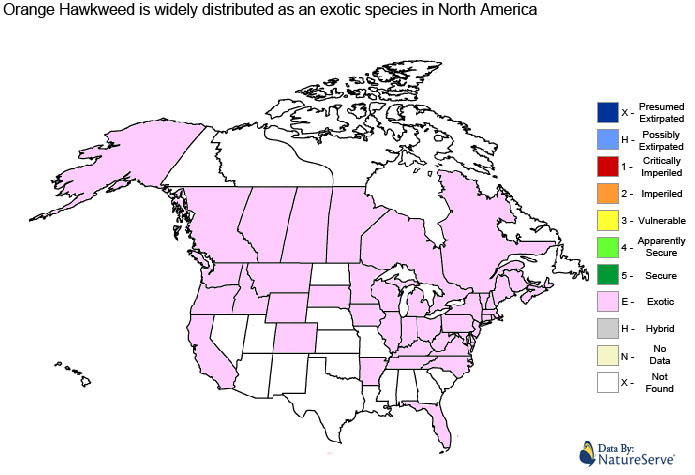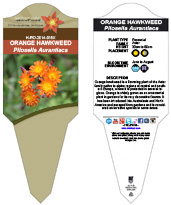

| Plant Name | Orange Hawkweed | |
| Scientific Name | Pilosella Aurantiaca | |
| Family | Aster | |
| Plant Type | Perennial | |
| Start of Blooming Season | June | |
| End of Blooming Season | August |

| Soil Conditions | |
| Soil Moisture | |
| Sunlight | |
| Notes: |

Orange hawkweed is a is a low-growing plant with shallow fibrous roots and a basal rosette of elliptical to lanceolate leaves 5cm to 20cm long and 1cm to 3cm wide. The flowering stem is usually leafless or with just one or two small leaves. The stem and leaves are covered with short stiff hairs (trichomes), usually blackish in colour. The stems may reach a height of 60 cm and have 2–25 capitula (flower heads), each 1omm to 25mm in diameter, bundled together at the end of short pedicels. All parts of the plant exude a milky juice. The flowers themselves come in a range of colours from a deep rust-orange to a pure yellow and often show striking gradients of colour. The flowers are hermaphrodite (have both male and female organs) and are pollinated by Apomictic. The plant is self-fertile. The plants propagates through its wind-dispersed seeds, and also vegetatively by stolons and shallow rhizomes.


No known health risks have been associated with orange hawkweed. However ingestion of naturally occurring plants without proper identification is not recommended.
 |
INVASION ALERT Orange hawkweed is a highly invasive species and is banned by many jurisdictions for deliberate cultivation. Check with local conservation authorities before attempting to cultivate this species. |

 |
-Click here- or on the thumbnail image to see an artist rendering, from The United States Department of Agriculture, of orange hawkweed. (This image will open in a new browser tab) |

 |
-Click here- or on the thumbnail image to see a magnified view, from The United States Department of Agriculture, of the seeds created by orange hawkweed for propagation. (This image will open in a new browser tab) |

Orange hawkweed can be referenced in certain current and historical texts under the following five names:
Orange hawkweed can be translated into the following select languages:
| Arabic | Bulgarian | Chinese (Sim) | |||
| Croatian | Czech | jestřábník | Danish | ||
| Dutch | Esperanto | Estonian | |||
| Finnish | French | épervière | German | Habichtskraut | |
| Greek | Χιεράτσιο | Hebrew | ההירציונים | Hungarian | |
| Italian | Japanese | Korean | |||
| Low Saxon | Lithuanian | vanagių | Norwegian | ||
| Persian | Polish | Portuguese | |||
| Romanian | Russian | ястребинка | Slovak | jastrabník | |
| Spanish | Swedish | Tagalog | |||
| Turkish | Ukrainian | Нечуйвітер | Vietnamese |

| The information provided in this conservation assessment has been provided by the Natureserve Database in conjunction with various federal, provincial, state, county, district, regional, and municipal governments as well as public and private conservation authorities. Information in this section is accurate from the last time this article was updated. | |
 |
Orange hawkweed has no conservation status as it is considered an exotic and or invasive species in North America. |

 |

 |
The MIROFOSS database offers free printable garden tags for personal and non-profit use. These tags can be used to properly identify plant samples in a garden. Click on the tags shown on the the screen or -click here- to download a full size jpeg image for an orange hawkweed identification tag; which can be printed on paper or used with a plastic laser printer. |
 |
What's this? What can I do with it? |

| Description / Application | Peterson, Roger Tory; McKenny, Margaret (1968). A Field Guide to Wildflowers of Northeastern and North-Central North America. Houghton Mifflin Company Boston. ISBN 0-395-18325-1. |
| Description | Field Guide to Noxious and Other Selected Weeds of British Columbia (2002). "Orange Hawkweed (Hieracium aurantiacum)" |
| Folklore | Edsall, Marion (2007-12-15) [1985]. Roadside Plants and Flowers A Traveler's Guide to the Midwest and Great Lakes Area. |
| Image Rendering | USDA-NRCS PLANTS Database / USDA NRCS. Wetland flora: Field office illustrated guide to plant species. USDA Natural Resources Conservation Service. |
| Environment | National Audubon Society. Field Guide To Wildflowers (Eastern Region): Alfred A. Knopf. pp 415-420 ISBN 0-375-40232-2 |
| Physical Identification | National Audubon Society. Field Guide To Wildflowers (Eastern Region): Alfred A. Knopf. pp 415-420 ISBN 0-375-40232-2 |
| May 30, 2015 | The last time this page was updated |
| ©2021 MIROFOSS™ Foundation | |
 |